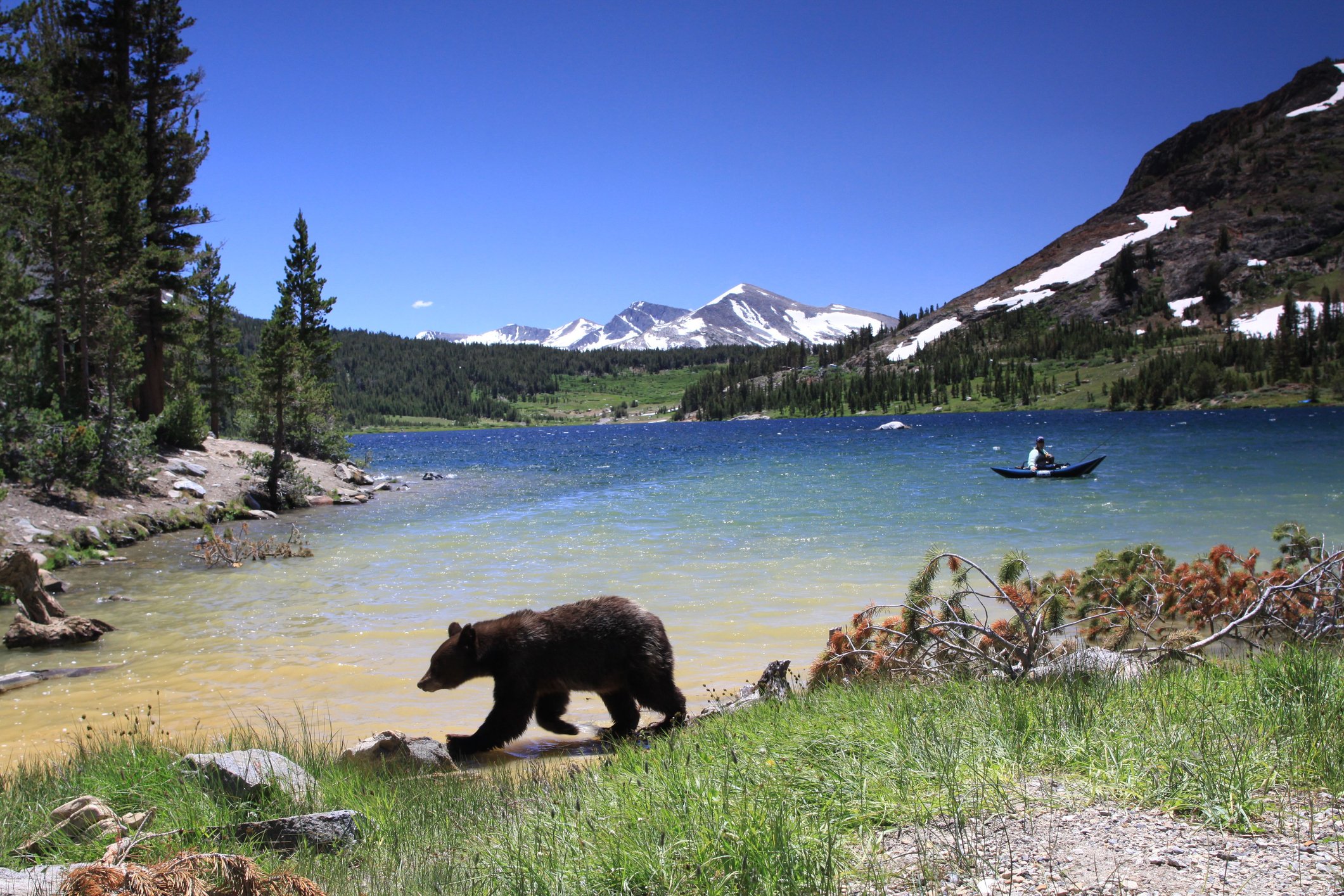
Securing Food, Garbage, and Gear
When recreating in bear country, it is essential to secure food, garbage, and other items that have an odour. Bears have keen senses of smell and may investigate anything they think might be food.
If you’re leaving attractants unattended (like leaving a backpack on shore when swimming in a lake) or setting up a camp, make sure any bear attractants are made inaccessible to bears and, if you’re spending the night, stored 100 yards (91.4 meters) away from your sleeping area. If you’re on a day outing, like a hike or a bike ride, and have food or other attractants with you, you don’t need to worry about storing them in a bear-resistant manner unless they will be unattended. (But don’t forget to pack out all trash like wrappers, apple cores, and other food waste.)
Below, we’ve listed some of the main bear attractants you may have when recreating and ways to make sure they’re secure from bears, whether you’re backpacking, camping, hunting, fishing, or doing any other outdoor activity.
Many public lands, including some national forests and national and provincial parks, have food storage orders that require you to make sure your food and other attractants are inaccessible to bears and other animals. Before you head out, check the appropriate government or area website to learn more about specific requirements for the area. (You can find some of these requirements compiled on the IGBC website.)
What’s an Attractant?
A bear attractant is simply anything that draws a bear to it due to the item’s scent, which makes a bear think it’s food (even if it has no nutritional value). Here are some attractants you may have with you when recreating:
Food and food containers and wrappers
Drinks and drink containers, except plain water
Garbage
Recycling
Pet food, bowls, and treats
Coolers
Portable stoves and fuel
Cookware and utensils
First aid supplies
Cosmetics and personal hygiene products (e.g., soap, toothpaste, deodorant, lotions, etc.)
Sunscreen
Bug spray
Specific to hunters:
Deer/wildlife feed or bait
Game carcasses
Used game meat bags
Unlocked vehicles (Vehicles themselves aren’t necessarily an attractant, but bears will get in them to investigate smells. Don’t leave any odorous item in an unlocked vehicle or in the back of a pick-up truck. Some areas do not allow you to keep food stored in vehicles, even if they are locked; check local requirements.)
The above list includes attractants that are usually used when recreating, but there are many other bear attractants. Check out our Ultimate List of Bear Attractants to see what other things can draw bears to an area.
Securing Attractants
There are several ways to keep attractants away from bears. Whatever method you choose, make sure ALL attractants are out of your tent or sleeping area.
-
Some campgrounds, including some designated backcountry campsites, offer metal storage lockers for your convenience. If you stash your attractants in one of these lockers, make sure it is properly latched.
-
There are many different types of bear-resistant canisters that are great for backpacking. These canisters can be hard-sided and double as a stool, or lightweight yet durable bags. Whatever product you choose, it should be placed 100 yards (91.4 meters) downwind from your sleeping site.
In addition to a bear-resistant canister, you can use an odour-proof barrier bag to help limit odours a bear might investigate.
Before you buy a canister, make sure that it is certified as bear-resistant by the IGBC and that it is approved for the area you will be in (some areas require specific types of canisters). And before heading out, make sure you know how to lock and unlock the canister.
Find a list of certified bear-resistant canisters on our Bear-resistant Products page.
-
Particularly handy for river trips or hanging out by the lake, bear-resistant coolers are a great option for safely storing food while it’s unattended.
Don’t forget to lock your cooler! While a cooler may be labeled bear-resistant (look for the IGBC certification), it is not bear-resistant unless it is locked. You can use padlocks, nuts and bolts, or locks made specifically for bear-resistant coolers. Whatever you choose, make sure the cooler lid cannot be lifted.
Find a list of certified bear-resistant coolers on our Bear-resistant Products page.
-
Hanging your food and garbage out of reach of bears when you’re not using it is one of the more common ways to store attractants.
When hanging your attractants from a tree, they should be at least 10 feet (3 meters) above the ground and 4 feet (1.2 meters) away from the trunk and branch from which they are hanging.
To hang attractants, find a tree branch that is 100 yards (91.4 meters) downwind from your sleeping site and will allow your attractants to be high enough from the ground and far enough away from the trunk. Put all attractants in a bag or stuff sack and tie a rope to the bag. Tie a rock or other weighted object to the other end of the rope, and toss it over the tree branch. Hoist the bag at least 10 feet (3 meters) off the ground, and tie off the loose end of the rope to a nearby anchor, like another tree.
Bear poles are essentially humanmade tree branches. These metal or wood structures provide a spot that will allow you to hang your attractants, including game carcasses at the required height and distance from edges. Keep an eye out for them at campsites and designated backcountry sites.
-
Electric fencing is an option for securing not only your food and garbage, but your entire campsite. Lightweight, portable electric fence kits (like this UDAP one) are a good option. Whatever electric fencing set up you choose, make sure the energizer will provide a strong enough shock for a bear.
